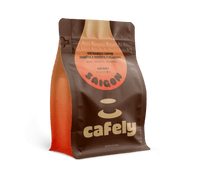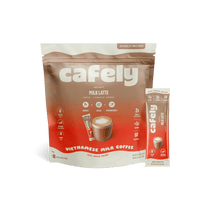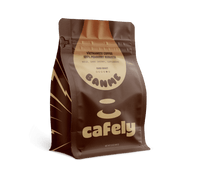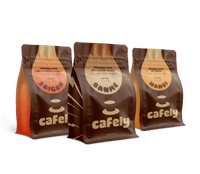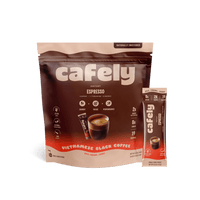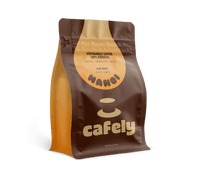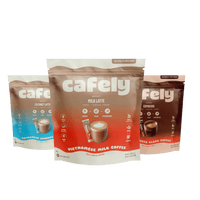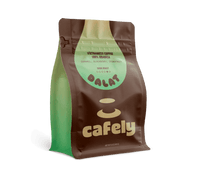With its layers of espresso-soaked ladyfingers, whipped mascarpone, and a dusting of cocoa, tiramisu has long been a favourite among dessert lovers. But for people sensitive to caffeine or those curious about what’s in their dessert, one question often comes up — Does tiramisu have caffeine?
In this article, we’ll explore exactly where the caffeine comes from, how much may be in each slice, and what factors influence the final amount.
Does Tiramisu Actually Contain Caffeine?
Yes, traditional tiramisu does contain caffeine because it’s soaked in freshly brewed coffee.
Most tiramisu recipes call for dipping ladyfingers (also called savoiardi) in strong brewed coffee or espresso before layering them with mascarpone cream. That liquid gets absorbed and locked into the dessert, bringing the caffeine with it.
In addition to the coffee, tiramisu is also topped with a dusting of cocoa powder. Cocoa naturally contains some caffeine, though in smaller amounts than coffee.
So if you’re watching your maximum caffeine intake, especially in the evening, tiramisu isn’t completely caffeine-free.
Main Sources of Caffeine in Tiramisu

The caffeine in tiramisu doesn’t come from anything artificial or added for effect. It’s simply a byproduct of two classic ingredients — coffee and cocoa.
Here’s how each one contributes:
1. Coffee Soaked Ladyfingers
The ladyfingers used in tiramisu are typically dipped in the strongest coffee, often espresso or double-strength brewed coffee. This soaking step is essential to tiramisu’s bold flavor and signature texture.
The liquid seeps deep into the biscuits and doesn’t evaporate, so whatever caffeine was in the coffee stays in the dessert.
Here are a few key details that influence caffeine levels:
- Type of Brew Used — Espresso contains more caffeine per ounce than average drip coffee. If the recipe calls for espresso or a concentrated brew, the final dessert will carry a higher caffeine load.
- Amount of Coffee Used in the Recipe — Some recipes soak heavily. Others brush the coffee on. A longer soak means more caffeine.
- Bean Variety — Arabica beans, commonly used in dessert-friendly espresso blends, contain less caffeine than robusta beans. Robusta has nearly double the caffeine content, though it’s less common in home kitchens.
Depending on how the tiramisu is made, a single serving could have anywhere from 30 to 70 mg of caffeine, roughly the same as a cup of tea or a small coffee.
If you’re highly sensitive or trying to cut back, it’s worth asking how the dessert was prepared (or modifying your recipe).
2. Cocoa Powder
That pretty dusting of cocoa on top naturally contains a bit of caffeine, and it also carries theobromine, a related stimulant with milder effects.
Cocoa contains an average of 12 mg of caffeine per tablespoon, but most tiramisu slices only have a light sprinkle. A single portion of tiramisu might have less than half a teaspoon of cocoa — contributing 1 to 3 mg of caffeine at most.
While cocoa isn’t a big caffeine player, it does nudge the number upward slightly, especially when paired with espresso-soaked layers.
So, yes, cocoa powder adds a little caffeine to the mix, but it’s a minor player compared to the coffee itself.
Estimating Caffeine Content: How Much Is in a Serving?
There’s no single standard — it depends entirely on how the dessert is made. From the brewing method to the portion size, several variables influence the final amount of caffeine in a serving.
Let’s break it down so you know exactly what factors to look for when estimating caffeine content.
1. Type of Coffee
Espresso contains significantly more caffeine per ounce than regular drip coffee, around 60 to 75 mg per shot (30 to 44 ml), compared to 90 to 120 mg in an 8-ounce cup of drip coffee.
However, tiramisu recipes that use espresso usually require smaller quantities of liquid. That means the total caffeine added can vary depending on whether the recipe uses espresso in a concentrated soak or a larger volume of brewed coffee.
If a recipe calls for two shots of espresso, that’s already 120 to 150 mg of caffeine before even factoring in the cocoa. If it uses a cup of weak drip coffee instead, the total may be far lower.
2. Amount of Coffee Used
Some tiramisu recipes soak the ladyfingers until they’re fully saturated, while others call for just a quick dip or even a brushed-on layer. The deeper and longer the soak, the more coffee gets absorbed, and the more caffeine ends up in each slice.
In restaurant kitchens, recipes often use a liberal amount of coffee to enhance flavor and texture. At home, especially in lighter or “healthier” versions, that volume may be significantly reduced.
A tiramisu made with just a few tablespoons of brewed coffee will contain far less caffeine than one that uses half a cup or more per layer.
3. Strength of Coffee Brew
Brew strength also matters. A light or medium roast brewed at home won’t carry the same caffeine punch as a dark, double-shot espresso pulled at a café.
Even within drip coffee, factors like the coffee-to-water ratio, bean variety like Vietnamese, and brewing method (classic French press, pour-over, etc.) influence how much caffeine is extracted.
If a tiramisu uses French press coffee brewed with a high bean ratio, it may deliver more caffeine than you’d expect, even if it’s not labeled “espresso.”
4. Cocoa Content
A single tablespoon of unsweetened cocoa powder contains about 12 mg of caffeine. Most tiramisu recipes use much less than that, perhaps 1 to 2 teaspoons sprinkled across the entire top layer.
That means each slice might get 1 to 3 mg of caffeine from cocoa alone. It’s a relatively minor contributor, but it does add to the total, especially if extra cocoa is used between layers or in decorative swirls.
There’s also variation in the type of cocoa. Dutch-processed cocoa tends to have slightly less caffeine than natural unsweetened cocoa, though the difference is small.
Some recipes may even mix cocoa with powdered sugar or other ingredients, which further dilutes the caffeine content.
5. Serving Size

A small square of tiramisu will contain less caffeine than a restaurant-sized portion piled high with layers. Some homemade versions are cut into modest slices with light soaking, while others are served as generous wedges with rich, saturated layers of espresso.
If you’re eating half the tray (no judgment), your caffeine intake could double or triple. Likewise, a mini portion might barely register on your system, even if made with espresso.
This also matters when feeding kids or people who are caffeine-sensitive. A child’s portion may only be a few bites, but if the recipe used real espresso, even those small bites can deliver a noticeable kick.
6. The Typical Caffeine Range of Tiramisu
There’s no way we can give you the exact caffeine content of every tiramisu out there. But based on common ingredients and preparation styles, here’s what you can expect:
- Low-end estimate — A tiramisu made with a small amount of weak coffee and minimal cocoa may contain as little as 10 to 15 mg of caffeine per serving. That’s less than half the caffeine in a can of cola and far below the average cup of tea.
- Mid-range estimate — A typical homemade or store-bought tiramisu using about half a cup of brewed coffee and a light cocoa dusting may contain 30 to 60 mg of caffeine per slice. That’s roughly on par with green or black tea.
- High-end estimate — A generously soaked tiramisu using multiple shots of espresso, especially if topped with extra cocoa or made with espresso powder, can exceed 100 mg of caffeine per serving. That’s more than a can of Red Bull and close to a full cup of strong coffee.
In other words, tiramisu can either be a light dessert with a hint of buzz or a true hidden caffeine bomb.
To help put that in perspective, here are the caffeine levels of common beverages:
- Drip Coffee (8 oz) — 95 to 120 mg
- Espresso (1 shot) — 60 to 75 mg
- Black Tea (8 oz) — 40 to 70 mg
- Green Tea (8 oz) — 20 to 45 mg
- Cola (12 oz) — 30 to 40 mg
- Dark Chocolate (1 oz ) — 12 mg
- Decaf Coffee (8 oz) — 2 to 5 mg
If your slice of tiramisu contains the equivalent of a full espresso shot, it could hit the same caffeine level as a small cup of coffee, not something everyone expects from a dessert.
If you’re ordering tiramisu in a restaurant, don’t hesitate to ask how it’s made if you’re worried about caffeine content. Some places might even offer a caffeine-free version or be willing to use decaf on request.
If you make tiramisu at home, you can tailor the recipe to your preference. Add more coffee for a stronger flavor, or use decaf if you’re after the taste without the late-night jitters.
Considerations for Caffeine-Sensitive Individuals
If you're sensitive to stimulants or managing a health-related concern, here's what to keep in mind before you grab a slice:
1. Impact on Sleep
For caffeine-sensitive people, even a small dose of espresso can linger longer than expected, and tiramisu delivers it in a deceptively sweet package. Eating it in the evening might not seem like a big deal, but it could be enough to disrupt your sleep cycle.
Caffeine blocks adenosine — a chemical that helps signal your brain it's time to wind down [1]. If you're eating tiramisu after dinner, especially one made with strong espresso, it can delay your ability to fall asleep or reduce the depth of your sleep.
People who metabolize caffeine more slowly — a trait that’s often genetic — may feel wired for hours after just a small portion. If you avoid coffee after a certain hour, you may want to skip tiramisu in the evening too.
2. Pregnancy and Caffeine
Most health organizations, including the American College of Obstetricians and Gynecologists (ACOG), recommend limiting caffeine to around 200 mg per day while pregnant.
While tiramisu may not push someone over that limit on its own, it still contributes to the daily total, especially when paired with other sources like tea, chocolate, or soda.
A single slice could contain 30 to 80 mg of caffeine, depending on how it’s made. That might seem minor, but it's worth counting if you're nearing your limit.
Many traditional tiramisu recipes include raw egg yolks whipped into the mascarpone cream. If those eggs aren’t pasteurized, there’s a risk of salmonella — a concern during pregnancy when the immune system is naturally suppressed.
Pregnant women should only eat tiramisu made with pasteurized eggs or pre-cooked alternatives. Many store-bought versions are safe, but homemade recipes vary, so always check.
3. Children and Caffeine
Between the coffee and cocoa, the caffeine in just one slice can be enough to cause jitteriness, trouble sleeping, or even mild anxiety in children.
Health guidelines typically suggest that children under 12 consume no more than 45 to 85 mg of caffeine per day, depending on their age and size [2].
Some restaurant-made tiramisu slices could push those limits in just a few bites. While small amounts are unlikely to cause harm, it’s best to treat tiramisu as a dessert for special occasions and to keep portions tiny when sharing with children.
Kids may be more sensitive to the bitterness of espresso and cocoa, which can overpower the sweetness in tiramisu. Even if they like it, parents should weigh the potential stimulant effects before serving it close to bedtime or in large amounts.
4. Caffeine-Free Alternatives
It’s entirely possible to make or buy caffeine-free tiramisu using decaffeinated coffee. A decaffeinated espresso or brewed coffee still provides the flavor and moisture needed to soak the ladyfingers, but with only 2 to 5 mg of caffeine per cup, the final dessert becomes much more accessible for people with sensitivities or medical conditions.
There are even some tiramisu variations that use common coffee alternatives, like chicory or roasted barley drinks, though these may alter the flavor profile slightly. Still, for those avoiding caffeine entirely, they offer a workable and delicious workaround.
FAQs: The Caffeine Content of Tiramisu
Want to learn more about the caffeine content of tiramisu?
Here are the answers to some frequently asked questions:
1. How Much Caffeine Is Typically in a Serving of Tiramisu?
It depends on the recipe. A slice of tiramisu can contain anywhere from 10 mg to over 100 mg of caffeine, depending on the type and strength of coffee used, how much is absorbed by the ladyfingers, and the portion size.
2. Will Eating Tiramisu Keep Me Awake at Night?
It can, especially if you're sensitive to caffeine. The dessert contains caffeine mainly from coffee, and if eaten in the evening, it may interfere with sleep for some people. Pay attention to your tolerance and timing.
3. Is It Safe To Eat Tiramisu During Pregnancy?
Tiramisu can be safe in moderation, but two things matter — the caffeine content and whether the recipe includes raw eggs. Be sure to factor the caffeine into your daily limit and only eat versions made with pasteurized eggs. Always consult your doctor if unsure.
4. What Type of Coffee Is Used in Tiramisu, and Does It Affect Caffeine?

Most traditional recipes use strong brewed coffee or espresso. Espresso has more caffeine per ounce, but you may use less of it. The total caffeine depends on how much liquid is absorbed and the strength of the brew.
5. Does Tiramisu Provide an Energy Boost?
Yes, it can, for some people. The caffeine content may offer a mild stimulant effect, similar to drinking a small cup of coffee. The boost won’t be as strong, but it’s noticeable in some recipes.
6. How Strong Is the Coffee Flavor and Caffeine Effect in Tiramisu?
The coffee flavor is usually prominent, especially when the ladyfingers are soaked in espresso. As for the caffeine effect, it depends on how much coffee was used and how sensitive you are. Some feel a slight buzz, others barely notice it.
7. Should Children Avoid Eating Tiramisu Due to Caffeine?
It’s generally best to limit tiramisu for young children. The caffeine content (and sometimes alcohol, if included) isn’t ideal for kids. If served at all, it should be in very small amounts.
8. Do All Coffee-Flavored Desserts Contain Significant Caffeine?
Not all, but many do. Tiramisu contains more caffeine than most because coffee is a core ingredient, not just a flavoring. If you’re avoiding caffeine, always check the ingredients.
9. Can I Use Instant Coffee Like Nescafé for Tiramisu, and How Does That Change the Caffeine?
Yes, instant coffee works well. The final caffeine content depends on how much coffee powder you use and how concentrated you make the soak. Using a smaller amount or less concentrated coffee can help reduce the overall caffeine per slice.
10. Are There Ways To Make Tiramisu With Less or No Caffeine?
Definitely. The easiest way is to use decaf coffee or espresso in the soak. It still gives that rich coffee flavor but cuts the caffeine significantly, making it safer for evenings, pregnancy, or caffeine-sensitive individuals.
References:
- Landolt, H.-P. (2012). “No Thanks, Coffee Keeps Me Awake”: Individual Caffeine Sensitivity Depends on ADORA2A Genotype. Sleep, 35(7), 899–900.
- Temple, J. L., Bernard, C., Lipshultz, S. E., Czachor, J. D., Westphal, J. A., & Mestre, M. A. (2017). The safety of ingested caffeine: A comprehensive review. Frontiers in Psychiatry, 8(80).
